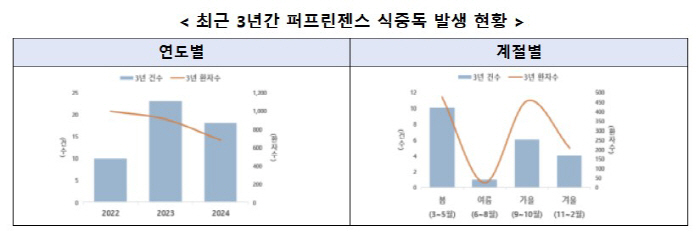Lunchbox Delivery Increasing Spring...Food poisoning Causes Perfringence Emergency
Mar 28, 2025
|
The Ministry of Food and Drug Safety held a meeting with delivery food franchises at the Korea Food Safety Information Service in Jung-gu, Seoul on the 28th to prevent food poisoning caused by delivery food such as lunch boxes and gimbap.
At the meeting, the Ministry of Food and Drug Safety shared the current status of food poisoning in delivery food and discussed how to prevent food poisoning in the cooking stage and how to revitalize the restaurant hygiene rating system, while listening to difficulties in the field.
It is pointed out that food poisoning caused by Clostridium perfringens bacteria (hereinafter referred to as perfringens) occurs a lot in spring (March to May), when the temperature rises, and the number of perfringens food poisoning caused by delivery food is increasing recently, so thorough food poisoning prevention management is necessary. In addition, food poisoning in Perfringens is also occurring in restaurants and group food service centers, so it is necessary to strengthen the hygiene management of food service businesses, such as complying with food poisoning prevention rules. In 2022, more than 90 construction site workers who received and consumed hundreds of servings of braised spicy chicken cooked in large quantities at restaurants showed symptoms of food poisoning and were detected as a result of analyzing the cause.
Perfringens bacteria occur mainly in meat-based cooking foods, and since they survive by making heat-resistant spores, even foods boiled enough can multiply again. Apo is produced in environments where certain bacteria such as Clostridium perfringens are difficult to survive, such as high temperatures and dryness, and remains dormant in the form of an apo, and then wakes up in the apo to multiply and produce toxins when bacteria grow.
In particular, it is characterized by growing well in an environment rich in amino acids, so cooking meat cooking foods such as bulgogi in large quantities and storing them at room temperature could lead to food poisoning caused by Perfringens bacteria. Accordingly, restaurants and group food centers must prepare meat dishes such as steamed meat and stir-fried spicy pork, which are major lunch box side dishes, and kimbap in large quantities, and then observe the storage method and temperature and provide them immediately.
When cooking meat in large quantities at restaurants or group cafeterias to prevent food poisoning from perfringens, it should be heated at a central temperature of 75℃ for at least 1 minute and provided immediately. If it should be provided after storage, it should be divided into several containers and refrigerated at 5℃ or less.
In addition, it is recommended that cooked food be consumed within 2 hours as much as possible, and if stored food is consumed again, reheated to 75℃ or higher.
In addition, it is recommended to store and transport gimbap and sandwiches that are frequently consumed during outdoor activities at 10°C or lower using an ice box because the risk of food poisoning increases if stored inside a sunny vehicle or in a trunk.
To prevent food poisoning, it is important to follow food poisoning prevention rules by thoroughly managing personal hygiene, such as washing hands, and using cooking tools such as knives and cutting boards separately by ingredients such as meat, fish, vegetables, and fruits to prevent cross-contamination.
At the meeting, Kim Seong-gon, Director of Food Safety Policy Bureau, said, `If food delivered in bulk is careless in handling, it can cause group food poisoning, so special attention should be paid to the preparation of food ingredients, cooking, storage, and transportationThe industry should follow food poisoning prevention methods such as washing hands and eating cooked food so that the public can consume food safely during the outing and endeavor to promote the sanitary rating system of restaurants," he said.
This article was translated by Naver AI translator.














